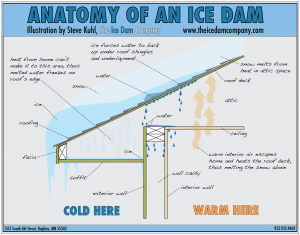Heated Gutters in Fairfax, VA
Using Heat Tape To Create A Heated Gutter
A heated gutter system consists of a gutter combined with self-regulating heat tape that is threaded through the gutters and downspouts beneath a gutter guard system. This heat tape warms the gutters during winter weather, effectively preventing issues caused by the accumulation of snow and ice.
Talk to us about Heated Gutters Today!
Why Heated Gutters?
If you are a homeowner living in a colder climate, dealing with snow and ice on your roof can be a constant concern, especially the threat of ice dams that can lead to leaks. Water damage resulting from these dams can become a serious and costly problem, turning into a nightmare for both you and your home.
During severe winter conditions, the damage caused by ice damming can be unprecedented, resulting in higher repair expenses. Additionally, large icicles hanging from the roof’s edge above walkways and driveways pose a safety hazard, increasing the risk of injury.
In extreme situations, the weight of accumulated snow and ice can exert enough force to cause gutters to pull away from the house, crack, or even fall completely.
To help prevent these issues and gain peace of mind, installing heat tape on your gutters is an effective solution. Heat tape is a specialized cable that warms up sufficiently to melt snow and ice, reducing the risk of ice dam formation without causing damage to your home.
What About Heated Tape on the Roof?
Unlike roof heat cables that lie on top of the roof and are snaked along the roof’s edge, heated gutter cables—sometimes called heat tape—are installed inside the gutters, just beneath a gutter guard system, and inside the downspouts. This approach, combining heated gutters with heated gutter guards, effectively prevents many of the issues commonly associated with using roof heat tape or heat cable alone.
The question of whether installing heat tape is truly worthwhile depends largely on proper installation. Various methods exist for installing heat cables, with the zigzag pattern being the most popular; this involves creating a triangular pattern on the first three feet of the roof, then lining the cable inside the gutter and downspout.
While installing heat tape on the roof can melt snow and ice there, it does not stop ice damming in or on the gutters themselves. Ice can still clog gutters and accumulate because the water flow becomes restricted. Moreover, this roof installation method has been shown to cause more long-term damage to the roof than having no cable at all, and it may even void your roof’s warranty.
Heat Tape works better inside a Gutter System
We use Weather-Ready heat tape installed exclusively on the inside of gutters and downspouts, ensuring that the shingles remain unaffected and the heat tape stays protected while focusing the heat solely on the gutters. This approach not only functions effectively but also maintains an appealing appearance. When the gutter guard is in place, it traps the heat generated by the tape inside, keeping the entire gutter system warm. As snow on the roof begins to melt, it encounters a warm gutter guard and gutter, which prevents the accumulation of ice and snow within the gutter system. This means the gutters handle only water, not ice, which is crucial for maintaining proper drainage.
For the best results, the heat cable should be activated just before snowfall. Heated cables for gutters are essential in regions with severe winters and heavy snowfall, as they help prevent ice dams and stop water from seeping into your home.
Snow Guards
Snow Guards, which should not be confused with Gutter Guards, are a valuable feature for roofs in snowy climates. They are specifically designed to prevent snow or ice from sliding off the roof all at once, which could create an avalanche effect and potentially fall onto landscaping or pedestrians below.
Ice Dams
Ice dams typically form when roof insulation is uneven or insufficient, or when other factors cause temperature variations that allow snow on the roof to melt. As the melted snow runs down the roof, it refreezes upon reaching the colder areas near the eaves. This process causes ice to accumulate along the roof’s edge or in the gutters, trapping more ice and water above it. Eventually, water can back up beneath the shingles, seeping into your attic, ceilings, and interior walls. Such water intrusion often results in costly repairs and may even require mold remediation.
What Causes Ice Damming?
There are a variety of reasons behind this problem. The most common reasons for ice damming are:

The pitch of a roof significantly influences the speed at which ice damming can develop, with lower pitches allowing ice dams to form more rapidly. Many homeowners notice ice dam formation near bathroom vents and chimneys, primarily due to temperature fluctuations in those areas.
Traditional roof heat cables are often installed on the roof surface; however, they do not prevent ice buildup above the heat tape itself. This can push the problem higher up on the roof, where the protective advantages of the drip edge and ice/water shield are less effective. When the heat tape melts snow, the resulting water may refreeze as it flows toward the gutters, which are typically colder because they are exposed to surrounding cold air. To address this, heated gutter systems use heat tape within the gutters themselves, warming the entire gutter system and effectively preventing ice buildup.
In contrast, without such a system, ice tends to accumulate first in the gutters, prompting many to wonder whether gutters themselves are responsible for causing ice dams.
Why Gutter Guards are an important part of a Heated Gutter System?
Gutter guards are primarily designed to prevent leaves and debris from clogging your gutters, but they also offer additional benefits. They help strengthen the gutter structure, protect the heat cable, and keep snow out of the gutter, allowing it to melt more quickly. When the heat tape is installed inside the gutter, it enables the entire system to warm up evenly, melting snow as it falls and reducing the risk of ice buildup that can cause water to seep into your home or result in large icicles hanging from your roof or gutters. Conversely, leaving the heat cable exposed to the elements can increase the likelihood of damage to the cable and cause leaves and debris to become caught on it, which can impair its effectiveness.
Are Heated Gutters Safe? What about potential fire hazards?
The Nuheat Weather-Ready heat tape installed by The Brothers that just do Gutters features a UV-resistant polyolefin outer jacket, a tinned copper braided layer, and a fire-resistant conductive core. To enhance safety and minimize the risk of fire caused by continuous electrical arcing from improper installation or damage to the heating cable, Nuheat Industries mandates equipment ground-fault protection on each heating cable circuit. In certain situations, a licensed electrician may be required to complete the final connection. It is important to note that installing the heat cable directly on the roof’s surface can pose a potential fire hazard.
How much electricity does it use?
Your actual electrical usage will depend on the length of the cable run, as this can affect how much power is consumed. The Nuheat Weather-Ready heat tape is designed to self-regulate its power output based on the surrounding conditions. When the ambient temperature drops, especially in the presence of ice or snow, the tape increases its power output to provide more heat. As the temperature of the water and ice rises, the tape automatically reduces its wattage and emits less heat. For further information, you can refer to our page on the cost of heated gutter systems.
Heated Gutter Demonstration
We put together a video demonstration of how a heated gutter system works. We placed piles of snow on top of the gutters so that viewers can see them melt through a time-lapse video.
For best results, your heat cable should be turned on prior to the snowstorm… so that the heated gutter will melt the snowflakes as they land. Once there is an accumulation of ice or snow, it will melt but takes more time and energy.
Note: For this simulation, we started with a mound of snow already on the gutter; during an actual snowstorm the flakes will melt as they land on the heated gutter. Be sure to visit our many blogs on this topic.
Installing Heat Tape – Using Heat Tape To Create A Heated Gutter
When installing heat tape, several factors need to be carefully considered. One important aspect is the spacing, which depends on the roof’s pitch and the soffit’s length. The heated cable is typically installed into your gutters and downspouts, with the preferred method being placement under a gutter guard. We highly recommend using a gutter guard because it offers protection for the cable and helps trap heat, thereby enhancing the overall effectiveness of the system. This approach can significantly reduce concerns related to ice dams.
For powering the heat tape, you can use a pre-cut length of heat tape or a GFCI plug-in cord set that connects to an existing outdoor outlet, which avoids the need for hardwiring. If there is no suitable outdoor outlet available or if your setup makes these options impractical, we advise consulting an electrician to handle the final power connection, ensuring safety and proper installation.
Table of Contents
Why Heated Gutters?
What about Heat Tape on the Roof?
Heat Tape works better inside a Gutter System
Snow Guards
Ice Dams
What Causes Ice Damming?
Why Gutter Guards are an important part of a Heated Gutter System?
Are Heated Gutters Safe? What about potential fire hazards?
How much electricity does it use?
Heated Gutter Demonstration
Installing Heat Tape
Talk to us about Heated Gutters Today!
Design the Perfect Gutter System
Complete the form today to book your free gutter estimate! Our solutionist will guide you through your options and craft a custom system for your house.



